1993 CHEVROLET CAMARO tow
[x] Cancel search: towPage 135 of 358
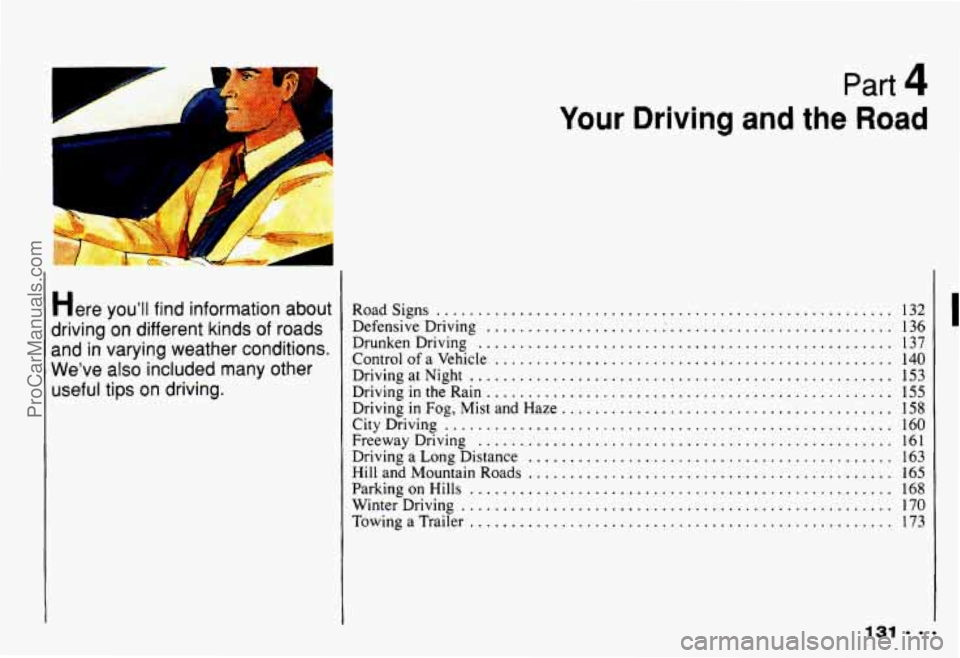
Part 4
Here you’ll find information about
driving on different kinds
of roads
and in varying weather conditions
.
We’ve also included many other
useful tips
on driving .
Your Driving and the Road
Roadsigns .......................................................
Defensive Driving ..................... t ...........................
DrunkenDriving ..................................................
Control of a Vehicle ................................................
DrivingatNight ...................................................
Driving in the Rain .................................................
Driving in Fog, Mist and Haze ........................................
Driving a Long Distance ............................................
Winter Driving ....................................................
Towing a Trailer ...................................................
CityDriving ......................................................
FreewayDriving ..................................................
HillandMountainRoads ............................................
ParkingonHills ...................................................
132
136
137
140
153
155
158
160 161
163
165
168
170
173
ProCarManuals.com
Page 140 of 358

Your Driving and the Road
136
Slowing down: If time allows, tap the
brake pedal once or twice
in advance of
slowing or stopping. This warns the driver
behind you.
Disabled: Your four-way flashers signal
that your vehicle
is disabled or is a
hazard. See “Hazard Warning Flashers”
in
the Index.
Traffic Officer
The traffic police officer is also a source
of important information. The officer’s
signals govern, no matter what the traffic
lights or other signs say.
The next section discusses some of the
road conditions you may encounter.
Defensive Driving
The best advice anyone can give about
driving
is: Drive defensively.
Please start
with a very important safety
device
in your Chevrolet: Buckle up. (See
“Safety Belts”
in the Index.)
Defensive driving really means “be ready for anything.“ On city streets,
rural roads,
or freeways, it means “always expect the
unexpected.”
Assume that pedestrians or other drivers
are going
to be careless and make
mistakes. Anticipate what they
might do.
Be ready for their mistakes.
Expect children
to dash out from behind
parked cars, often followed
by other
children. Expect occupants
in parked cars
to open doors into traffic. Watch for movement
in parked cars - someone
may be about
to open a door.
Expect other drivers
to run stop signs
when you are
on a through street. Be
ready
to brake if necessary as you go
:hrough intersections.
You may not have
:o use the brake, but if you do, you will be
-eady.
If you’re driving through a shopping
center parking
lot where there are
well-marked lanes, directional arrows,
and designated parking areas, expect
some drivers to ignore all these markings
and dash straight toward one part of the
lot.
ProCarManuals.com
Page 166 of 358
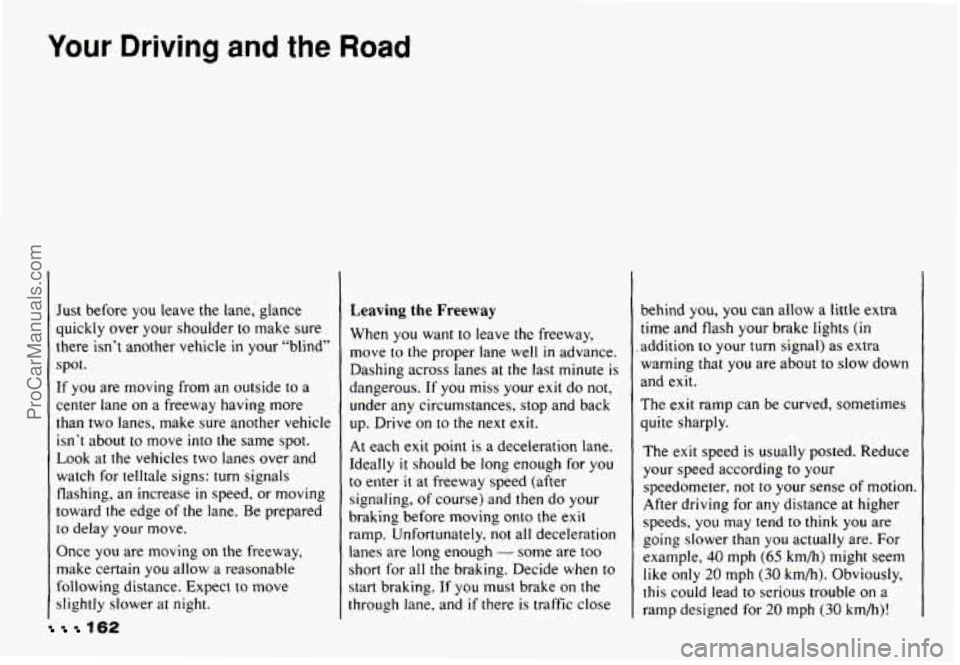
Your Driving and the Road
Just before you leave the lane,’ glance
quickly over your shoulder to make sure
there isn’t another vehicle
in your “blind”
spot.
If you are moving from an outside to a
center lane on a freeway having more
than two lanes, make sure another vehicle
isn’t about
to move into the same spot.
Look
at the vehicles two lanes over and
watch for telltale signs:
turn signals
flashing, an increase
in speed, or moving
toward the edge of the lane. Be prepared
to delay your move.
Once
you are moving on the freeway,
make certain you allow
a reasonable
following distance. Expect
to move
slightly slower at night.
162
Leaving the Freeway
When you want to leave the freeway,
move to
the proper lane well in advance.
Dashing across lanes at the last minute is
dangerous. If you miss your exit do not,
under any circumstances, stop and back
up. Drive on
to the next exit.
At each exit point is a deceleration lane.
Ideally
it should be long enough for you
to enter it at freeway speed (after
signaling,
of course) and then do your
braking before moving onto the exit
ramp. Unfortunately, not all deceleration
lanes are long enough
- some are too
short for
all the braking. Decide when to
start braking. If you must brake on the
through lane, and
if there is traffic close behind you, you can allow
a little extra
time and flash your brake lights
(in
addition to your turn signal) as extra
warning that you are about to slow down
and exit.
The exit ramp can be curved, sometimes
quite sharply.
The exit speed
is usually posted. Reduce
your speed according to your
speedometer, not
to your sense of motion.
After driving for any distance at higher
speeds, you
may tend to think you are
going slower than you actually are. For
example,
40 mph (65 km/h) might seem
like only
20 mph (30 km/h). Obviously,
this could lead
to serious trouble on a
ramp designed for
20 mph (30 km/h)!
ProCarManuals.com
Page 171 of 358

Know how to go uphill. You may
want
to shift down to a lower gear.
The lower gears help cool your engine
and transmission, and
you can climb
the
hill better.
Stay
in your own lane when driving
on two-lane roads in hills or
mountains. Don’t swing wide or cut
across the center of the road. Drive at
speeds that let you stay
in your own
lane. That way, you won’t be surprised
by a vehicle coming toward you
in the
same lane.
It takes longer to pass another vehicle
when you’re going uphill. You’ll want
to leave extra room to pass. If a
vehicle is passing you and doesn’t
have enough room, slow down
to
make it easier for the other vehicle to
get
by.
As you go over the top of a hill, be
alert. There could be something
in
your lane, like a stalled car or an
accident.
0
You may see highway signs on
mountains that warn
of special
problems. Examples are long grades,
passing or no-passing
zones, a falling
rocks area, or winding roads. Be alert
to these and take appropriate action.
Winter driving can present special problems. See
“Winter Driving” in the
Index.
ProCarManuals.com
Page 177 of 358

Run your engine only as long as you
must. This saves fuel. When you
run the
engine, make
it go a little faster than just
idle. That is, push the accelerator slightly.
This uses less fuel for the heat that you
get and
it keeps the battery charged. You
will need a well-charged battery to restart
the vehicle, and possibly for signaling
later on
with your headlights. Let the
heater
run for awhile.
Then. shut the engine off and close the
window almost all the way to preserve the
heat. Start the engine again and repeat this
only when you feel really uncomfortable
from the cold.
But do it as little as
possible. Preserve the fuel as long as you
can.
To help keep warm. you can get out
3f the vehicle and do some fairly vigorous
zxercises every half hour or
so until help
Zomes.
If You're Stuck in Deep Snow
This manual explains how to get the
vehicle
out of deep snow without
damaging it. See "Rocking Your Vehicle"
in the Index.
Towing a Trailer
you can lose control when you pull
a trailer. For example, if the trailer is
too heavy, the brakes may not work
well - or even at all. You and your
passengers could be seriously
injured. Pull a trailer only if you
have followed all the steps in this
section.
ProCarManuals.com
Page 178 of 358
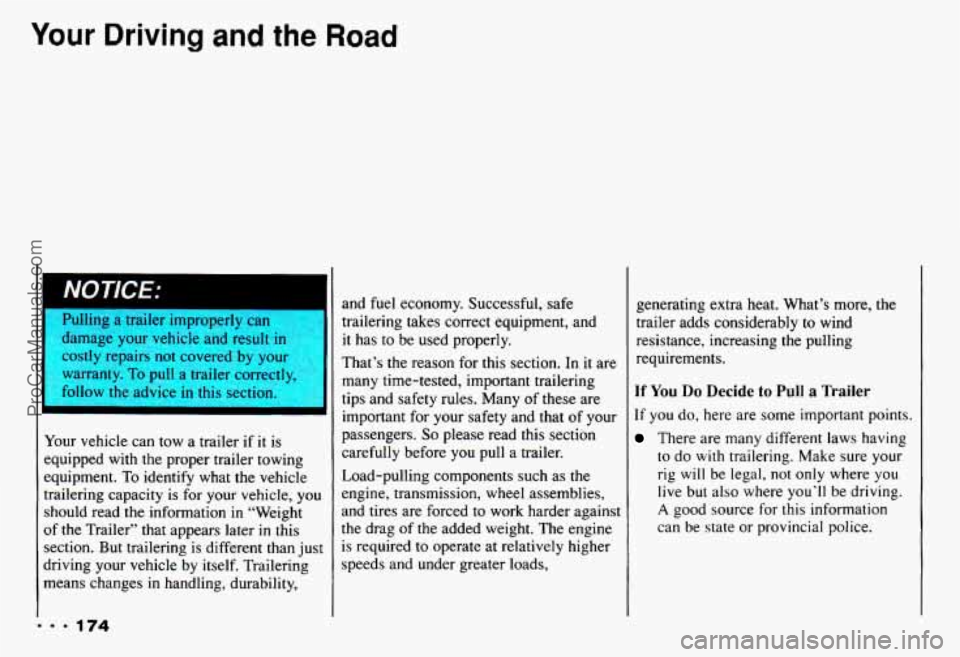
Your Driving and the Road
I NOTICE:
AAtnage your vehicle and result i~
jtly repairs not covered by you.
warranty.
To pull a trailer correctly,
follow the advice
in this section.
I
Your vehicle can tow a trailer if it is
equipped
with the proper trailer towing
equipment.
To identify what the vehicle
trailering capacity
is for your vehicle, you
should read the information in “Weight
of the Trailer” that appears later
in this
section. But trailering is different than just
driving your vehicle by itself. Trailering
means changes
in handling, durability, and fuel economy.
Successful, safe
trailering takes correct equipment, and
it has to be used properly.
That’s the reason for this section, In it are
many time-tested, important trailering
tips and safety rules. Many of these are
important for your safety and that of your
passengers.
So please read this section
carefully before you pull a trailer.
Load-pulling components such as the
engine, transmission, wheel assemblies,
and tires are forced to work harder against
the drag of the added weight. The engine
is required to operate at relatively higher
speeds and under greater loads, generating extra
heat. What’s more,
the
trailer adds considerably to wind
resistance, increasing the pulling
requirements.
If You Do Decide to Pull a Trailer
If you do, here are some important points.
There are many different laws having
to do
with trailering. Make sure your
rig
will be legal, not only where you
live but also where you’ll be driving.
A good source for this information
can be state or provincial police.
ProCarManuals.com
Page 179 of 358
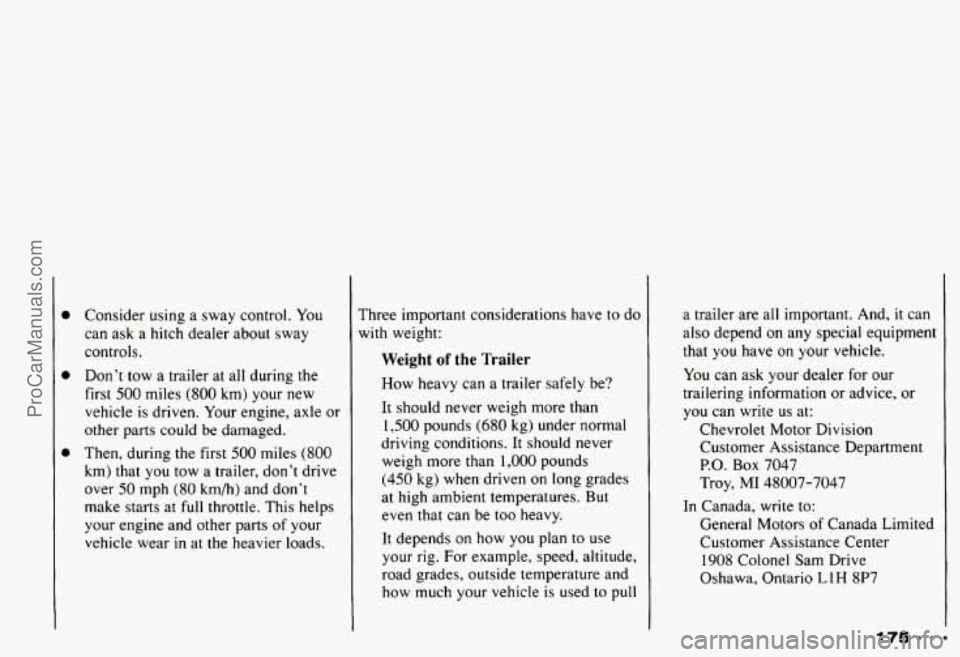
Consider using a sway control. You
can ask a hitch dealer about sway
controls,
Don’t tow a trailer at all during the
first
500 miles (800 km) your new
vehicle is driven. Your engine, axle or
other parts could
be damaged.
Then, during the first
500 miles (800
km) that you tow a trailer, don’t drive
over
50 mph (80 km/h) and don’t
make starts at full throttle. This helps
your engine and other parts of your
vehicle wear
in at the heavier loads. Three
important considerations have to do
with weight:
Weight of the Trailer
How heavy can a trailer safely be?
It should never weigh more than
1,500 pounds (680 kg) under normal
driving conditions. It should never
weigh more than
1,000 pounds
(450 kg) when driven on long grades
at high ambient temperatures. But
even that can be too heavy.
It depends on how you plan to use
your rig. For example, speed, altitude,
road grades, outside temperature and
how much your vehicle is used to pull a
trailer are all important. And,
it can
also depend on any special equipment
that you have on your vehicle.
You can ask your dealer for our
trailering information or advice, or
you can write
us at:
Chevrolet Motor Division
Customer Assistance Department
P.O. Box 7047
Troy, MI 48007-7047
In Canada, write to:
General Motors
of Canada Limited
Customer Assistance Center
1908 Colonel Sam Drive
Oshawa, Ontario
LlH 8P7
ProCarManuals.com
Page 180 of 358
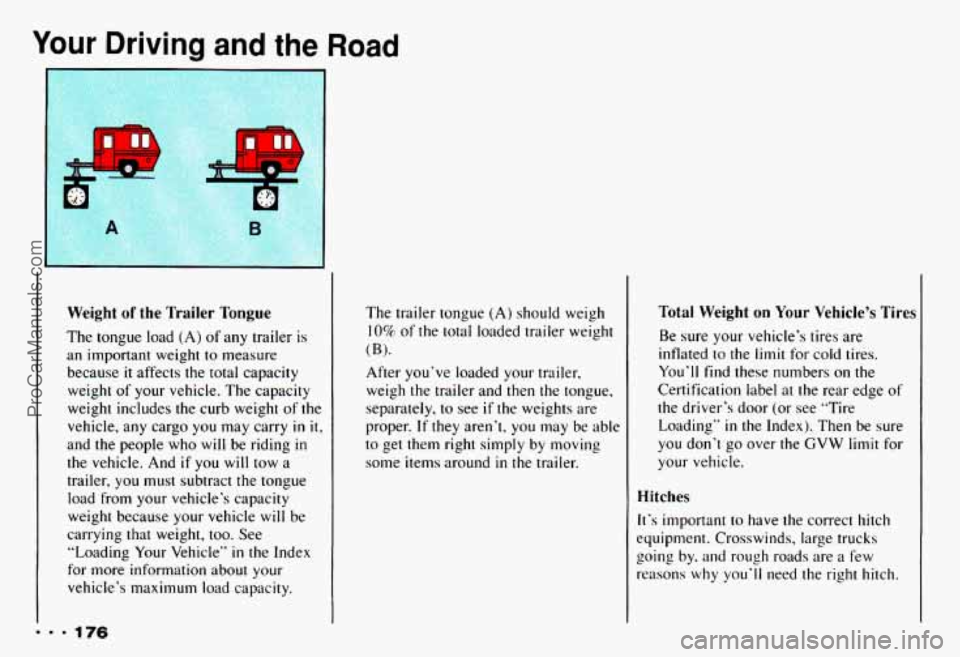
Your Driving and the
Weight of the Trailer Tongue
The tongue load (A) of any trailer is
an important weight to measure because
it affects the total capacity
weight of your vehicle. The capacity
weight includes the curb weight
of the
vehicle,
any cargo you may carry in it,
and the people who will be riding in
the vehicle. And if you will tow a
trailer, you must subtract the tongue load from your vehicle‘s capacity
weight because your vehicle
will be
carrying that weight, too. See
“Loading Your Vehicle”
in the Index
for more information about your
vehicle’s
maximum load capacity.
Road
The trailer tongue (A) should weigh
10% of the total loaded trailer weight
(E).
After you’ve loaded your trailer,
weigh the trailer and then the tongue,
separately, to see
if the weights are
proper.
If they aren’t, you may be able
to get them right simply
by moving
some items around
in the trailer.
Total Weight on Your Vehicle’s Tires
Be sure your vehicle’s tires are
inflated to the
limit for cold tires.
You’ll
find these numbers on the
Certification label at the rear edge of
the driver’s door (or see “Tire
Loading”
in the Index). Then be sure
you don’t go over
the GVW limit for
your vehicle.
Hitches
It‘s important to have the correct hitch
equipment. Crosswinds, large trucks
going
by. and rough roads are a few
reasons
why you’ll need the right hitch.
ProCarManuals.com